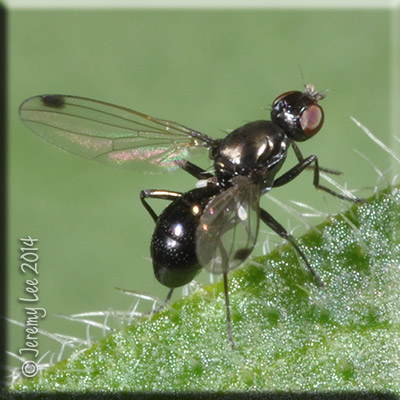
 |
|
Scientific Classifications explained » Amphibians » Ants » Aphids » Bees » Beetles » Birds » Bugs » Butterflies » Caterpillars » Damselflies » Dragonflies » Earwigs » Flies » Frog/Leafhoppers » Fungi » Galls » Grasshoppers » Harvestmen » Hoverflies » Lacewings » Ladybirds » Leaf Mines » Lichens » Mammals » Millipedes » Mosses » Moths » Sawflies » Slugs » Snails » Spiders » Trees & Shrubs » Wasps » Wild Flowers » Woodlice » Postboxes |
UK Nature > Flies > Sepsis fulgens

Scientific Name: Sepsis fulgens Common Name: Lesser Dung Fly Sepsis fulgens, more commonly known as a Lesser Dung Fly, is a small (2.7 to 3.4 mm) fly, and is an ant mimic. It has a very shiny dark body and each wing has a dark 'shade'. There are several similar species and accurate identification in the field may not be possible. This fly is often seen visiting flowers on order to get a carbohydrate meal. It is most often associated a variety of animal dung, particularly that of cows and horses. Often groups of these flies 'dance' on a leaf, waving wings and legs. Can be seen most months of the year. The female will lay her eggs on cow or horse dung and the larvae will feed on it. Male Sepsis fulgens are often more common on dung, as it here that they will wait for the females. In fact, males are so keen, that they will very often mount any visiting fly that bares a slight resemblance to another Sepsis, including other males, but they will quickly dismount again when the error is apparent. Common and widespread in Britain. |
|

https://www.uknature.co.uk is a website dedicated to showing the immense diversity of UK nature and wildlife. Our vast range of habitats, from lowland arable to snow covered mountains, from storm-ravaged coastlines to peaceful inland freshwater lakes and rivers, from dry, sandy heaths to deciduous and coniferous forests, all these habitats contribute to the abundance of UK nature. We have wild birds in huge numbers either residing or visiting our shores (597 recorded species as at July 2013) and we must also not forget the humble back garden with its grass lawns, flower beds filled with nectar rich flowers, shrubs and trees, all designed to attract huge numbers of insects such as bees, moths, butterflies and hoverflies; and finally the small ponds which provide safe havens for frogs, toads, newts and even slow worms and grass snakes. www.uknature.co.uk is the showcase for my personal passion, photographing uknature in all its glory. I sincerely hope you all enjoy the fruits of my labours. This site and all images contained therein is © Jeremy Lee 2004 - 2025. All Rights Reserved. Site design by Jeremy Lee. Site development & IT Support by Stuart Lee. |